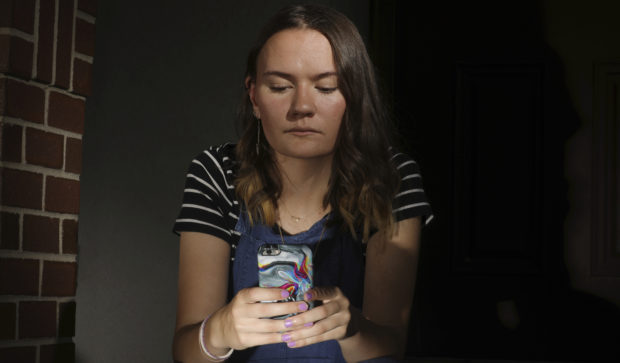How to spot signs your child is being cyberbullied
LOS ANGELES – Millions of students around the country will soon be on holiday break. While they may get away from some of the bullying on school grounds, it won’t be the end of bullying.
Over the holiday break, cyberbullying is expected to kick into high gear. With most kids having access to platforms where cyberbullying can take place and others getting new electronic devices as gifts this season, it is an issue that should be on parents’ minds.
“Parents must know about cyberbullying so they can help protect it and end it when it happens,” says Kirk Smalley, co-founder of Stand for the Silent. “It is an issue that we all need to know about because we are just about all online at one point or another.”
1 in 6 high school students experience cyberbullying

In this 2019 photo, Rachel Whalen looks at her phone at her home in Draper, Utah. Whalen remembers feeling gutted in high school when a former friend would mock her online postings, threaten to unfollow or unfriend her on social media and post inside jokes about her to others online. The cyberbullying was so distressing that Whalen even contemplated suicide. AP Photo/Rick Bowmer)
According to the Centers for Disease Control and Prevention (CDC), 1 in 6 high school students report having been cyberbullied.
Those in middle school tend to experience the highest amounts of cyberbullying, followed by those in high school. CDC notes that 33 percent of middle school students have been cyberbullied.
While elementary students do not experience it nearly as much, 5 percent still report having been cyberbullied. It is an issue and concern that stretches across all academic years.
Add to that the results of a study published in the Canadian Medical Association Journal that says social media can affect adolescents’ self-view and interpersonal relationships.
CDC reports that this is because there is a comparison and negative interaction that takes place, including cyberbullying. Plus, it says that social media normalizes and even promotes self-harm among youth.
How to spot the signs a child is being cyberbullied
Knowing the dangers and realities of cyberbullying is the first step for parents. The next is learning how to identify it taking place and what to do about it.
Most adolescents are not going to tell their parents they are being cyberbullied, so parents must pay attention to the signs they may be displaying.
Cyberbullying happens in an online format, such as social media and texting, and can include threats, rumors, accusations, and embarrassing and false posts.
Some of the signs that may point to a child being cyberbullied include:
- Pulling away from using technology when they used to like it
- Being secretive about being online or on their phone
- Quickly turning a screen off when a parent enters the room
- Behaving nervously when using technology
- Begins avoiding usual behaviors that they typically enjoy
- Being upset or mad after using their phone
- Withdrawing from their family or friends
- Deleting their social media accounts or creating new ones
- Noticeable changes in their mood or having difficulty sleeping
Creating a safe space
Parents who suspect that there may be cyberbullying taking place will want to start by creating a safe space for their child.
Their child needs to know that they are not being judged, that they are not at fault for someone’s cyberbullying, and that they can discuss the issue with you.
It is also recommended to record all details and save them because they may be needed later. Report all cyberbullying to social media outlets and speak with the other parents and schools about the issue. Threats of violence should also be reported to the police.
“We have to get this issue under control, especially with more electronics in the hands of our youth,” adds Smalley. “This takes a community effort, and parents take the issue seriously. We have helped many communities take this issue on, and we have no plans of stopping.”
Stand for the Silent
Smalley and his wife, Laura, started Stand for the Silent after their 11-year-old son ended his own life due to bullying. They turned their pain and loss into a mission of helping others.
He travels the country giving presentations about bullying to schools, providing bullying prevention, giving out scholarships and offering intervention strategies.
Those interested in getting involved can start a chapter of the group in their area, obtain a free K-2 bullying prevention curriculum or cyberbullying handbook for parents, host a presentation at their school, and donate to help support the cause.
To get more information, visit the Stand for the Silent website.

